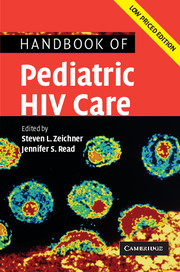Book contents
- Frontmatter
- Contents
- List of contributors
- List of abbreviations
- Foreword
- Preface
- Part I Scientific basis of pediatric HIV care
- Part II General issues in the care of pediatric HIV patients
- Part III Antiretroviral therapy
- 11 Antiretroviral therapy
- 12 Antiretroviral drug interactions
- 13 Metabolic complications of antiretroviral therapy in children
- 14 HIV drug resistance
- 15 Initiating and changing antiretroviral therapy
- 16 Therapeutic drug monitoring
- 17 HIV postexposure prophylaxis for pediatric patients
- Part IV Clinical manifestations of HIV infection in children
- Part V Infectious problems in pediatric HIV disease
- Part VI Medical, social, and legal issues
- Appendix 1 Formulary of antiretroviral agents
- Appendix 2 National Institutes of Health sponsored clinical trials for pediatric HIV disease
- Appendix 3 Selected HIV-related internet resources
- Appendix 4 Selected legal resources for HIV-infected children
- Index
- References
13 - Metabolic complications of antiretroviral therapy in children
Published online by Cambridge University Press: 23 December 2009
- Frontmatter
- Contents
- List of contributors
- List of abbreviations
- Foreword
- Preface
- Part I Scientific basis of pediatric HIV care
- Part II General issues in the care of pediatric HIV patients
- Part III Antiretroviral therapy
- 11 Antiretroviral therapy
- 12 Antiretroviral drug interactions
- 13 Metabolic complications of antiretroviral therapy in children
- 14 HIV drug resistance
- 15 Initiating and changing antiretroviral therapy
- 16 Therapeutic drug monitoring
- 17 HIV postexposure prophylaxis for pediatric patients
- Part IV Clinical manifestations of HIV infection in children
- Part V Infectious problems in pediatric HIV disease
- Part VI Medical, social, and legal issues
- Appendix 1 Formulary of antiretroviral agents
- Appendix 2 National Institutes of Health sponsored clinical trials for pediatric HIV disease
- Appendix 3 Selected HIV-related internet resources
- Appendix 4 Selected legal resources for HIV-infected children
- Index
- References
Summary
Introduction
The introduction of highly active antiretroviral therapy (HAART) has revolutionized the care of HIV-1 infected children and adults in the developed world, However, unforeseen toxicities attributable to the use of HAART continue to emerge. Pediatricians who care for HIV-infected children and adolescents increasingly face a population that has had extensive and prolonged exposure to HAART. These toxicities have been described extensively in the adult literature yet the definitions of particular syndromes, their etiology, prevalence, diagnosis, and management remain unclear. The consequences of these changes for the overall health of the patients are also uncertain. The pediatric data are quite limited. The available information suggests that the manifestations of these toxicities in HIV-infected children can be subtle and may vary with developmental stage. Younger children may have different presentations than adults. Metabolic complications have been reported in association with the use of nucleoside reverse transcriptase inhibitors (NRTIs) and protease inhibitors (PIs). Non-nucleoside reverse transcriptase inhibitors (NNRTIs) have not been directly implicated. There may be significant intraclass variability, with respect to individual drug effects. The complications discussed in this chapter will include the fat redistribution syndrome, abnormalities in lipid and glucose metabolism, and hyperlactatemia and lactic acidosis.
Fat redistribution syndrome, lipid abnormalities, and insulin resistance
Background
This constellation of clinical and laboratory abnormalities is often referred to as the lipodystrophy syndrome, but a uniform case definition of lipodystrophy in the context of HIV infection does not yet exist.
- Type
- Chapter
- Information
- Handbook of Pediatric HIV Care , pp. 382 - 396Publisher: Cambridge University PressPrint publication year: 2006
References
- 1
- Cited by



